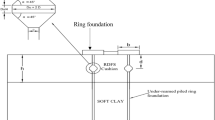Abstract
This paper studied the numerical simulation of wet deposited Phosphogypsum (PG) embankment on an existing dry one by the Plaxis and Midas GTS geotechnical codes. Following the sequences of PG embankment construction, a plane strain model permitted the simulation of the conventional wet deposit process of PG. Mohr-Coulomb constitutive model with appropriate parameters describe the behavior of Tunisian Phosphogypsum residue. The implementation of suitable numerical procedure led to predict the evolution of settlements and horizontal displacements during the construction of PG embankment. Comparison between predictions by Plaxis and Midas codes overall showed similar trends, in particular, the occurrence of maximum settlements after the construction of peripheral basins located at the crest of PG embankment, while the lowest settlement occurs under the central basin located at the axis of whole PG embankment. For each stage of PG embankment construction, the predictions showed constant settlement. The adopted stage construction scheme highlighted alternated settlement and heave movements, from which observed in situ cracks within the PG deposited PG were justified.











Similar content being viewed by others
Abbreviations
- TCG:
-
Tunisian Chemical Group
- PG:
-
Phosphogypsum
- HDPE:
-
High-density polyethylene
- DDPG:
-
dry deposited Phosphogypsum
References
Arama ZA, Çinicioğlu SF, Öser C (2015) Analysis of embankment widening problems. The XVI ECSMGE geotechnical engineering for infrastructure and development. Conference Proceedings. SN : 978-0-7277-606. Chapter XIII : 3821-3826
Bhawan P, Nagar EA (2014) Guidelines for management, handling, utilisation and disposal of phosphogypsum generated from phosphoric acid plants. Hazardous Waste Management Series. Central Pollution Control Board, New Delhi
Brinkgreve RBJ, Kumarswamy S, Swolfs WM et al (2019) Plaxis 2D - tutorial manual. Plaxis
Fuleihan NF (2012) Phosphogypsum disposal-the pros & cons of wet versus dry stacking. Procedia Engineering 46:195–205
Http://www.greenpeace.org/eastasia/Global/eastasia/publications/reports/food-agriculture/ 2013/ Living%20with%20Danger%20report.pdf (2013) Living with danger: In Investigation of phosphogypsum pollution in the phosphate fertilizer industry, Sichuan Province, China
Karoui H, Bouassida M (2015) Assessment of the foundation of Tunisia Ghezala Dam. Geotech Geol Eng. https://doi.org/10.1007/s10706-014-9825-9
Karoui H, Bouassida M (2016) Assessment of observed of behavior of Sidi El Barrak Dam (Tunisia). Innov Infrastruct Solut. https://doi.org/10.1007/s41062-016-0044-5
Maazoun H, Bouassida M (2018) Phosphogypsum management challenges in Tunisia. In: 1st International Conference on Advances in Rock Mechanics : Slope and open pit stability. 265-272, TuniRock 2018, Tunisia
Maazoun H, Bouassida M (2019) Phosphogypsum management perspectives. Massive valorization or massive storage? Acta Sci Agric. https://doi.org/10.31080/asag.2019.03.0584
Turgut B, Özalp M, Yildirimer S (2013) Determining of Spatial Variability of Penetration Resistance and Particle Size Distribution in Sediment Deposition . International Caucasian Forestry Symposium. 168 –173, Turkey
Tzenkov AD (2008) "Stability Analysis of a Tailings Dam: Existing State and Planned Heightening". International Conference on Case Histories in Geotechnical Engineering. 50
Valverde-Palacios I, Valverde-Espinosa I, Fuentes García R, Martín Morales M (2011) Geotechnical risk and environmental impact: the stability of phosphor-gypsum embankments in SW Spain. Electron J Geotech Eng
Author information
Authors and Affiliations
Corresponding author
Additional information
Responsible Editor: Zeynal Abiddin Erguler
Rights and permissions
About this article
Cite this article
Karoui, H., Maazoun, H. & Bouassida, M. Numerical simulation of wet deposited Phosphogypsum embankment resting on dry deposited one. Arab J Geosci 13, 817 (2020). https://doi.org/10.1007/s12517-020-05783-z
Received:
Accepted:
Published:
DOI: https://doi.org/10.1007/s12517-020-05783-z




